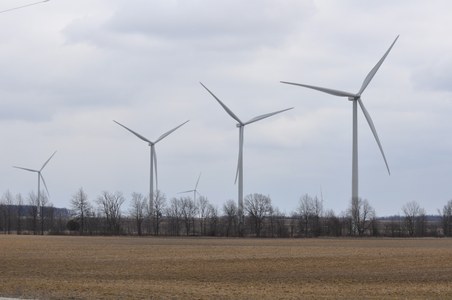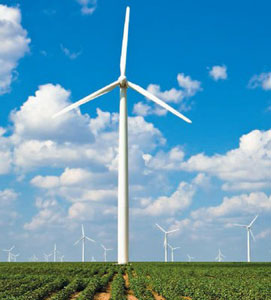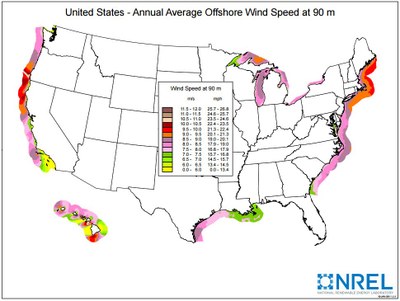For starters, with long-term power purchase agreements being signed for as low as 2 cents a kilowatt-hour, wind turbines are the low-cost provider of electricity in many regions of the country. Unlike coal, gas or nuclear power, they are also pollution free. No emissions of sulfur and nitrogen oxides or fine particles that contribute to respiratory problems; no radioactive wastes; and no carbon dioxide that is the major contributor to global warming. They also augment farm income through lease payments and increase the tax base of surrounding communities. In short, they are win-win economically and environmentally.
 Several of the 100 turbines located on the Headwaters Wind Farm in southeast Indiana.
Several of the 100 turbines located on the Headwaters Wind Farm in southeast Indiana.
 Double-cropping: soybeans and wind power
Double-cropping: soybeans and wind power
Today, there are more than 100,000 people employed in the U.S. wind industry, in jobs ranging from manufacturing to assembly and maintenance and with a median annual salary of $51,000. For good reason, these jobs are located in central regions of the U.S., extending east-west from Indiana to Colorado and north-south from Montana to Texas. Look at the following map, and you’ll see that this is where wind speeds are high and more power can be generated.
 Average Annual Wind Speeds across the U.S.
Average Annual Wind Speeds across the U.S.
In regions shaded from yellow to blue – red and blue being exceptional − the economics work well. Wind energy can be marketed at competitive prices, with a favorable return on capital investments. No surprise that Texas ranked first in wind power generation, followed by Iowa and Oklahoma. And in Oklahoma, Kansas, Iowa and South Dakota, wind power provides more than 30% of the electricity generated within the state.
Over the last ten years, US wind generating capacity has increased five-fold, from about 17,000 megawatts in 2007 to 85,000 megawatts in 2017. And, even with benign neglect at the federal level, capacity will continue to grow, driven by a bottom-up push from state and local governments, as well as the corporate sector. Major corporations – Amazon, Apple, General Motors, Google and Walmart, to name a few – are increasing their purchases of renewable energy, in some cases with the goal of achieving 100% by the end of the decade. Many cities are following suit, with Minneapolis targeting 100% by 2020, and led by California, states continue to raise their renewable portfolio standards. But will increasing demand be met only by generation in central regions of the U.S.?
Maybe not! The following map shows average coastal wind speeds, and if you happen to live in the Northeast, as I do for a good portion of the year, conditions should give you reason to believe that the region can participate in wind’s contribution to economic growth. From Maine to Maryland, average wind speeds exceed 20 miles per hour, and even as far south as the Carolinas, they approach 18 mph.
 Average U.S. Coastal Wind Speeds
Average U.S. Coastal Wind Speeds
But there are some obstacles, beginning with the need for “really” big turbines to take full advantage of the excellent winds. The average base-to-rotor tip height of today’s offshore turbines is nearly 600 feet, and each blade is about 200 feet long. Take a look at this graphic to get a feeling for their size and what it takes to manufacture and assemble them. Then consider that GE is on its way to building the world’s largest turbine with a height of 850 feet. Compare that with land-based turbines which have an average height of about 280 feet. Currently, there are no U.S. facilities capable of manufacturing critical offshore turbine components, including the turbine blades.
The other obstacle relates to cost. The European Union has taken the lead in developing and implementing offshore wind, and generating capacity in the North Sea has doubled over the last 3 years while costs have been reduced by 50% over the past 10 years. However, although today’s offshore wind would be competitive with building a new coal-fired power plant, the cost of electricity would still be 5 or more times larger than costs associated with land-based wind.
Although it would take a leap of faith to develop an offshore wind industry in the U.S., it appears that the first steps are about to be taken. Led by the States of New Jersey, New York, and Massachusetts, 8,000 megawatts of generating capacity could be in place by 2030, and related development of U.S. manufacturing and installation capabilities could create nearly 40,000 full-time U.S. jobs. Getting there will require significant support at state and federal levels and, at least over the near term, a willingness of rate payers to pay more for the electricity. I for one would be willing to do so. And I would enjoy the view afforded by large wind turbines off the New Hampshire shore.
I hope readers will see fit to encourage and support wind development efforts in their region, whether land-based or offshore. Those who know me know that I love to bicycle, and whether I do it on the plains of Indiana or the New Hampshire shore, there is always wind. On particularly windy days, I’ll often strengthen my resolve by muttering “the wind is my friend; she makes me stronger.” Well, more broadly, the wind is indeed our friend and we should do all we can to use its gift of energy.